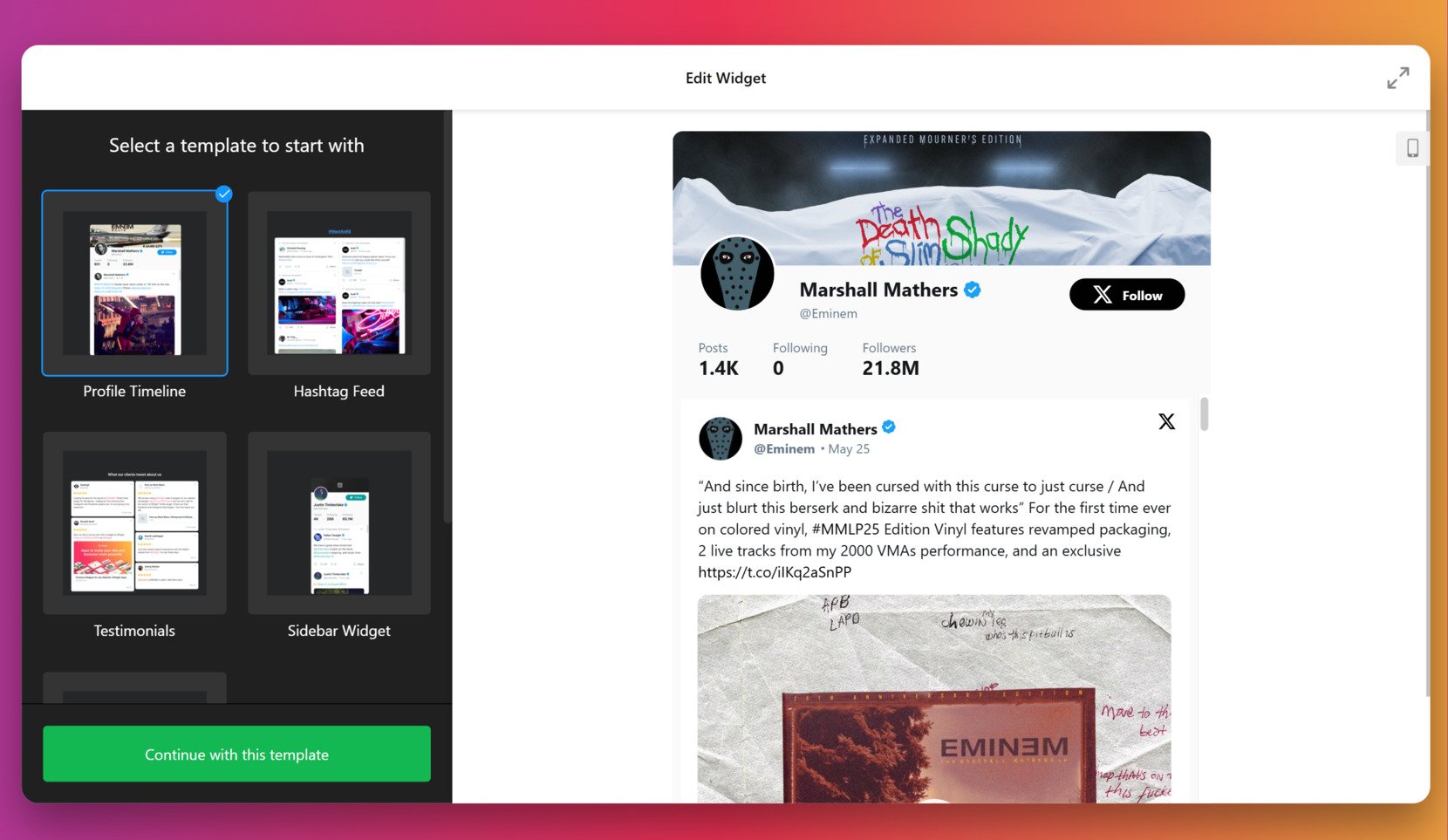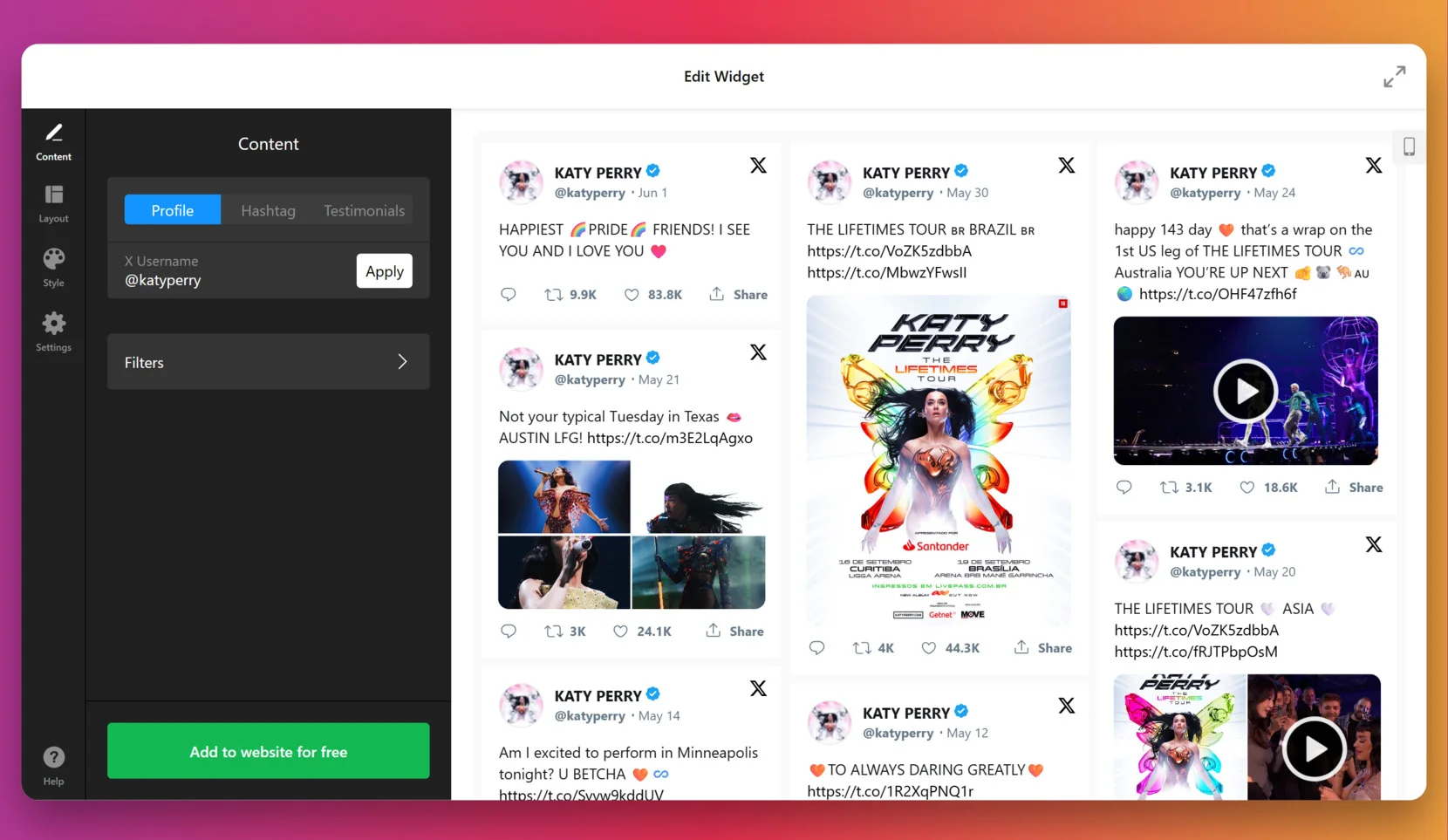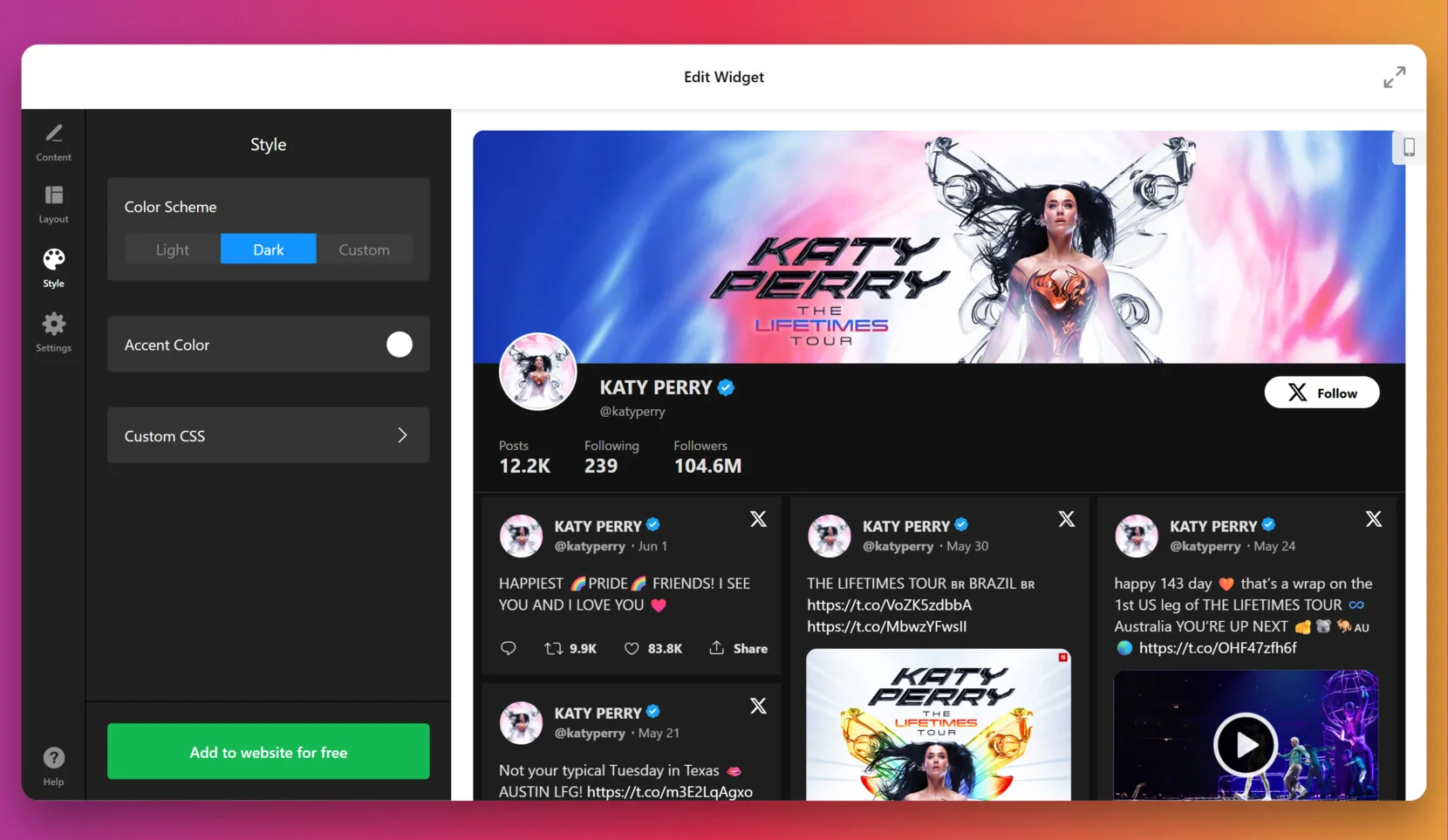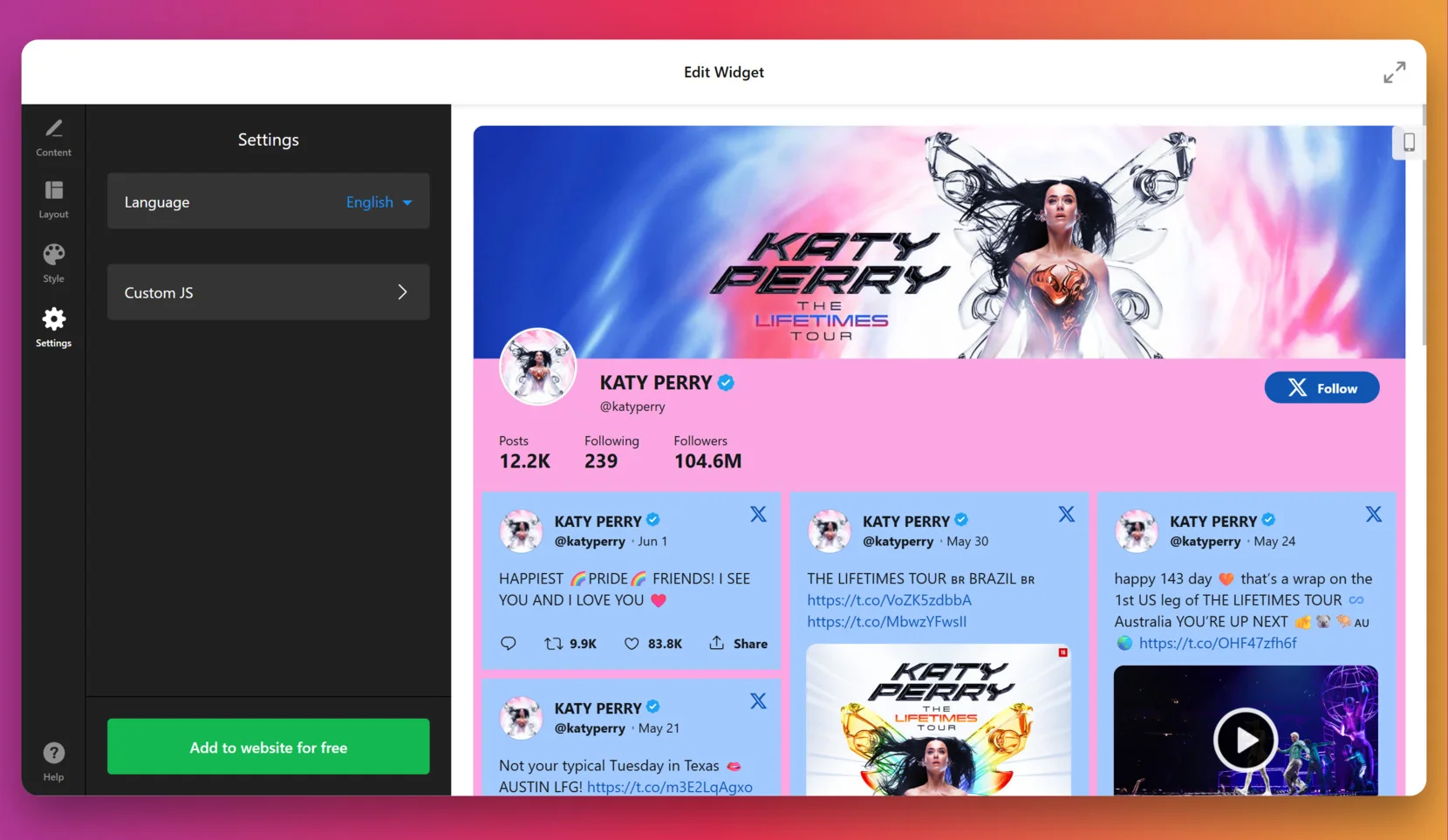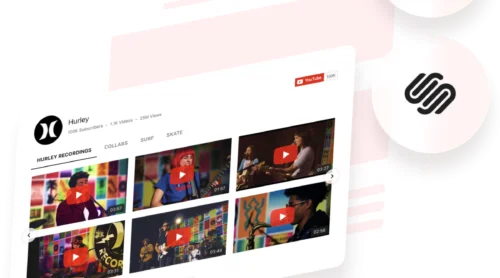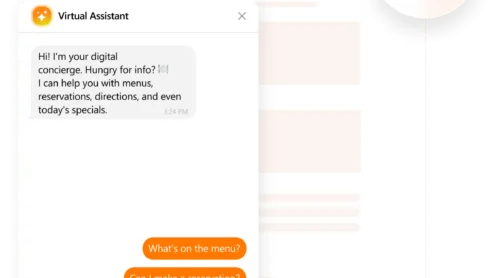Embedding a Twitter video on your website allows you to display real-time content from your Twitter account or any public tweet. Whether you’re highlighting a specific video, showcasing tweets from a hashtag, or curating branded media, it’s an effective way to add dynamic, trustworthy content that boosts engagement and keeps your website fresh.
Embedding a Twitter video on your website isn’t just about visual appeal — it helps you engage your audience, keep content fresh, and drive interaction with your social media channels. If you’re looking to enrich your website with dynamic media, this solution is exactly what you need.
- Keep your content automatically updated. Twitter videos update in real time, so your website always reflects your latest activity without manual uploads.
- Boost engagement through social media content. Video tweets are highly engaging and can increase user interaction and time spent on your website.
- Showcase your brand’s authenticity. Displaying media-rich tweets adds transparency and personality, helping visitors connect with your brand more easily.
- Drive more traffic to your Twitter profile. Embedded videos offer direct links back to your Twitter content, encouraging cross-platform engagement.
- Enhance website aesthetics and trust signals. Integrating recognizable, branded Twitter media contributes to a modern and credible online appearance.
Now that you know what a Twitter Feed is and why it matters, let’s explore how to quickly set one up using Elfsight’s ready-made solution.
Quick Setup of Your Twitter Video Feed
Now that you understand the value of adding Twitter videos to your website, let’s walk through the simplest way to get started. With Elfsight, you can create and embed a Twitter Feed widget in just a few clicks — no coding needed.
- Open the Elfsight editor and choose the Twitter Feed template.
- Paste the link to the tweet or profile you want to display video content from.
- Customize layout, alignment, colors, fonts, and other display options to match your branding.
- Click “Add to website for free“, copy the embed code, and paste it into your website’s backend.
This quick method allows you to place engaging video content from Twitter right on your website without relying on developers or complex integrations. It’s fast, flexible, and built for marketers, creators, and business owners alike.
See the widget in action – build your own Twitter Feed in minutes!
Key Features of Elfsight Twitter Feed
Once you’ve created your widget, Elfsight gives you powerful features to control how Twitter videos appear on your website. The tool is designed to simplify integration while offering advanced customization options that make your content more effective and engaging.
Here are the main features and benefits that make Elfsight’s Twitter Feed a smart choice:
- Embed video tweets with zero coding. Easily display Twitter videos by pasting a link — Elfsight handles the rest with a no-code embed solution.
- Support for multiple content sources. Show video posts from usernames, hashtags, handles, or curated collections in one unified feed.
- Responsive layout for all devices. Your embedded media adjusts automatically to mobile, tablet, and desktop screens, ensuring a perfect fit everywhere.
- Stylish customization options. Tweak colors, fonts, spacing, and layout styles to fully match your branding and website design.
- Moderation and filtering tools. Hide specific tweets or keywords to keep your feed relevant, clean, and on-brand.
- Automatic updates in real time. New tweets appear instantly, so your content stays current without manual refreshes.
- Easy installation with universal compatibility. Works seamlessly on all major platforms including HTML, WordPress, Shopify, and more.
With these features in place, you’re ready to move from quick setup to a more detailed guide on how to fully create and install your Twitter Feed with Elfsight.
Embed Twitter Video to Website: Full Guide
If you’re ready to go beyond the quick setup and want full control over the look and behavior of your embedded Twitter content, this guide will walk you through the complete process of building and installing your Elfsight Twitter Feed widget. No coding required — just intuitive steps and visual customization.
- Choose a Template. Open the Elfsight Twitter Feed editor and select your preferred layout, such as Profile Timeline or Hashtag Feed. Once selected, click “Continue with this template”.
- Add the Content Source. In the “Content” tab, select the type of feed — Profile or Hashtag — and enter the appropriate Twitter handle or tag. Press “Apply” to fetch the content.
- Customize the Layout. Navigate to the “Layout” section to adjust the visual format. You can enable or disable the header, choose what tweet elements to display (author, date, icons), and control spacing.
- Style Your Widget. Under the “Style” tab, pick from Light, Dark, or Custom color schemes. Set your accent color, apply a font, or use Custom CSS for advanced styling. Make the widget match your website branding.
- Adjust Settings. In the “Settings” tab, choose the widget’s language and apply any custom JavaScript if needed. This is also where you can enable additional technical configurations.
- Embed the Code on Your Website. Click “Add to website for free” and copy the embed code provided. Paste it into your website’s HTML or through your CMS’s code block or integration panel, then publish your changes.
These steps give you full flexibility to customize and display video tweets on your website in a way that fits perfectly with your design and content strategy.
With your custom Twitter Feed now live and styled to match your brand, you’re all set to share engaging Twitter videos with your audience. But if you’re curious about other ways to embed Twitter content, let’s look at a few alternative methods next.
Other Solutions to Twitter Video Integration
While Elfsight offers a fast and user-friendly way to embed Twitter videos, there are also official and alternative methods available for website owners. These methods vary in complexity and customization but are worth exploring for specific use cases or platforms. Below, you’ll find instructions for two widely used options: the native Twitter embed feature and manual integration using Twitter’s Publish tool.
Native Twitter Embed (Using Twitter Publish)
This is the official method provided by Twitter for embedding content directly from the platform. It allows you to add a single tweet, including those with videos, by generating a copy-paste embed code.
- Go to the tweet you want to embed. Navigate to the Twitter website and find the post that contains the video you want to display.
- Click on the share icon below the tweet. This icon looks like an arrow pointing upward from a tray.
- Select “Embed Tweet” from the dropdown. Twitter will redirect you to its official Publish tool with a preview of the embed.
- Customize if needed. You can uncheck “Include parent Tweet” if you want a cleaner layout.
- Copy the generated HTML code. Click the “Copy Code” button provided by Twitter.
- Paste the code into your website. Open your website’s backend, locate the desired HTML block or code section, and insert the embed code there. Save and publish your changes.
This method is ideal if you’re embedding one tweet at a time and don’t need additional content sources or style controls.
Manual Integration via Twitter Developer API
For developers, Twitter offers an API that enables advanced integration of video tweets and user timelines. This method provides complete control over how data is fetched and displayed, making it suitable for custom development projects.
- Create a Twitter Developer account. Visit developer.twitter.com and sign in with your Twitter account, then apply for a developer account.
- Create a Project and App. Once approved, create a new project and Twitter App from the dashboard to generate API keys.
- Generate Access Tokens. Obtain the bearer token or OAuth tokens required to authenticate your requests.
- Use the GET statuses/show/:id endpoint. This lets you retrieve tweet data including media URLs by specifying the tweet ID.
- Parse and render the video content. Using your frontend framework or backend logic, pull the video URL and insert it into your webpage using standard video or iframe tags.
This approach is flexible and scalable, but it requires programming skills and server-side handling for security and rate limiting.
Comparison of Twitter Video Embedding Methods
Here’s how these methods compare in terms of ease of use, flexibility, and customization. Each has its place depending on your needs — but Elfsight remains the most accessible and feature-rich solution for the majority of users.
| Method | Pros | Cons |
|---|---|---|
| Elfsight Twitter Feed | Provides an all-in-one solution with styling, filtering, and full video support — no coding required. | Advanced users may need CSS access for deep customizations beyond the UI settings. |
| Twitter Publish | Quick and official way to embed a single tweet with video using only a copy-paste code. | You can only embed one tweet at a time and can’t customize the layout or style deeply. |
| Twitter API | Enables full programmatic control over tweet content, great for large-scale or custom projects. | Requires developer skills, API setup, and hosting logic for dynamic rendering of content. |
Now that you’ve explored the alternative methods, the next section will help you understand when and how to make the most of your Twitter video embeds for better user experience and engagement.
Tips to Optimize Video Embeds
Embedding a Twitter video on your website doesn’t end with pasting the code — there are a few practical considerations that can improve visibility, responsiveness, and overall performance. Below are universal tips that apply to any widget, no matter the platform or tool you use.
- Place the video where users expect it. The most effective positions are near related content, such as a blog post or product description. Avoid placing it too far down the page where users might miss it.
- Make sure the embed is responsive. Always check that the embedded media adjusts properly on mobile and tablet devices. This often requires enabling responsive behavior in your widget or enclosing the code in a flexible container using CSS.
- Compress and lazy load where possible. If the widget allows it, enable lazy loading or asynchronous loading to reduce the initial page load time. This ensures video content doesn’t delay other key visual elements.
- Use concise tweet selections. When showcasing video tweets, choose those with clear messaging and minimal external distractions (like threads or replies), so viewers stay focused on the content.
- Test placement and performance regularly. After inserting video content from X, monitor how it performs — use basic analytics to see click-throughs or engagement to determine if placement or selection needs refinement.
- Avoid crowding the page with multiple feeds. One or two well-placed widgets are usually more effective than several scattered embeds. It keeps the user experience clean and digestible.
These tips will help you make the most of your embedded content and keep your layout user-friendly. Next, we’ll look at how different industries and roles can use Twitter video integration to their advantage.
Use Cases for Twitter Integration
Embedding Twitter videos can be valuable across multiple industries. It helps brands deliver authentic content, showcase real-time updates, and reinforce social proof directly on their websites. Below are examples of how different industries can effectively use Twitter Feed widgets.
Application in Media & Entertainment 🎥
News agencies, streaming platforms, and entertainment brands can use Twitter video feeds to share real-time updates, trailer releases, press conference highlights, or event footage. This brings immediacy to their websites and keeps followers engaged with the latest content directly from their Twitter accounts.
Application in E-commerce and Retail 👚
Retailers can use video tweets to highlight customer reviews, influencer mentions, unboxing clips, or product launches. Integrating this type of media helps build trust and increases conversions by showing how products are used and talked about in real time.
Application in Education and Public Institutions 🎓
Universities, nonprofits, and government organizations often share event coverage, community updates, or key announcements on Twitter. Embedding these videos on their websites helps centralize communication and maintain transparency with students, donors, or the public.
From public announcements to real-world product showcases, Twitter video feeds are proving effective across sectors. In the next section, we’ll address common embedding issues and show how to solve them quickly.
Fixing Common Issues
Even with a straightforward setup process, embedding Twitter videos may sometimes come with technical hiccups or unexpected limitations. Below are answers to the most common questions users face when integrating video content from Twitter into their websites.
Why is my embedded Twitter video not showing on the website?
The video embed breaks my layout. How can I fix it?
Can I embed a tweet with a video from a private account?
What to do if the Twitter Feed isn’t loading at all?
Why is my video tweet not centered or aligned correctly?
Can embedding too many tweets slow down my website?
Being aware of these common issues will help you avoid display problems and maintain a clean, professional look across devices.
Conclusion
Embedding Twitter videos on your website is one of the most effective ways to showcase social proof, deliver real-time updates, and keep your content fresh and dynamic. Whether you want to display user-generated clips, highlight brand announcements, or stream social media content from specific hashtags, video embeds help connect your audience with your brand’s voice in an authentic and engaging way.
Throughout this guide, we’ve explored different ways to embed Twitter videos, including native Twitter tools, API integrations, and Elfsight’s flexible widget solution. Elfsight stands out by combining ease of use with powerful customization, allowing you to manage and display your social media content without writing a single line of code.
Need Help or Want to Learn More?
We hope this guide gave you everything you need to start embedding Twitter videos successfully. If you’re looking to explore more ways to enhance your website with social media tools, feel free to reach out to us. At Elfsight, we’re committed to helping you create powerful, code-free widgets that drive results.
Join our growing Community to exchange ideas, ask questions, and contribute feedback. If you have suggestions or features you’d like to see, we encourage you to share them with us through our Wishlist — we’re always listening!


